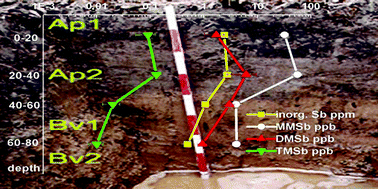Methylated arsenic, antimony and tin species in soils†
Abstract
Methylated species of antimony, arsenic and tin were examined in urban soils of the Ruhr basin, near the cities of Duisburg and Essen, Germany. The main aim of this study was to investigate the occurrence of mono-, di- and trimethylated species of these elements in urban soils. The influence of historical and present land use upon the species content was examined. The distribution of inorganic As, Sb and Sn and their methylated species along the profile depth was investigated. As, Sb and Sn speciation was performed by pH-gradient hydride generation purge and trap gas chromatography, followed by inductively-coupled plasma mass spectrometry (HG-PT-GC/ICP-MS). Species’ structures were confirmed by GC-EI/MS-ICP-MS. Monomethylated Sb and As were the dominant species detected: the concentration of these metal(loid) species varied between <0.07–56 μg kg−1 per dry mass. All dimethylated species and monomethyltin concentrations were between <0.01–7.6 μg kg−1 per dry mass, and for the trimethylated species of all examined elements, concentrations between <0.001–0.63 μg kg−1 per dry mass were detected. The highest organometal(loid) concentrations were observed in agricultural soils and garden soils; lower concentrations were found in the soils of abandoned industrial sites (wasteland, primary forest and grassland) and a flood plain soil of the Rhine. This result can be ascribed to both the cultivation and the increased biological activity of the agricultural soils, and the generally higher contamination, the disturbed structure and the artificial substrates (deposits from industrial sources) of the abandoned industrial soils. Due to periodical sedimentation, the flood plain profile was the only one where no depth dependence of organometal(loid) species concentration was detected. The other soil profiles showed a decrease of species content with increasing depth; this was particularly noticeable in soils with a clear change from a horizon with an organic character towards a mineral horizon, i.e. decreasing vitality from profile top to bottom. It is not as yet clear whether the organometal(loid) species are formed in the mineral horizons of the profiles or whether they are displaced from the organic, biologically-active horizons towards the mineral horizons. Field studies revealed that soil parameters like pH, water content or temperature did not correlate significantly with the degree of biomethylation observed. In contrast to the lower in vitro biomethylation efficiency of Sb vs. As in microbial incubations, we consistently detected higher proportions of transformed Sb compounds in situ in soil samples. These data may indicate a need to re-examine the currently accepted model of Sb biogeochemical cycling in the real environment.


 Please wait while we load your content...
Please wait while we load your content...